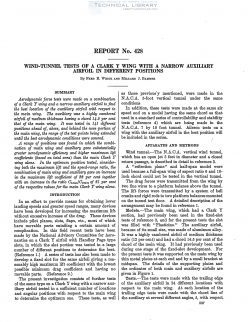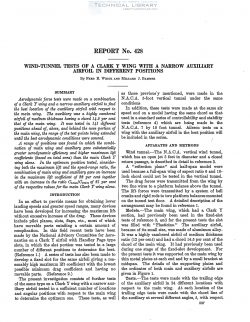naca-report-428

- Version
- 206 Downloads
- 1.01 MB File Size
- 1 File Count
- August 26, 2016 Create Date
- August 26, 2016 Last Updated
National Advisory Committee for Aeronautics, Report - Wind Tunnel Tests of a Clark Y Wing with a Narrow Auxiliary Airfoil in Different Positions

Aerodynamic force tests were made on a combination
of a Clark Y wing and a narrow auaiI/iary airfoil to find
the best location of the auayiliary airfoil with respect to
the main wing. The auxiliary was a highly cambered
airfoil of medium thickness having a chord 14.5 per cent
that of the main wing. It was tested in 141 diferent
positions ahead of, above, and behind the nose portion of
the main wing, the range of the test points being extended
until the best aerodynamic conditions were covered.
A range of positions was found in which the combi—
nation of main wing and a/asciliary gave substantially
greater aerodynamic eficiency and higher maximum lift
coefl‘icients (based on total area) than the main Olark Y
wing alone. In the optimum position tested, consider-
ing both the maximum lift and the speed-range ratio, the
combination of main wing and auxiliary gave an increase
in the maaimum lift coefficient of 32 per cent together
with an increase in the ratio OLmux/Opgun of 21 per cent
of the respective values for the main Clark Ywing alone.
In an effort to provide means for obtaining lower
landing speeds and greater speed ranges, many devices
have been developed for increasing the maximum lift
without excessive increase of the drag. These devices
include pilot planes, slots, flaps, etc., most of which
have movable parts entailing a certain amount of
complication. In this field recent tests have' been
made by the National Advisory Committee for Aero-
nautics on a Clark Y airfoil with Handley Page type
slots, in which the slat portion was tested in a large
number of different positions to determine the best.
(Reference 1.) A series of tests has also been made to
develop a fixed slot for the same airfoil giving a rea-
sonably high maximum lift coefficient with the lowest
possible minimum drag coefficient and having no
movable parts.
| File | Action |
|---|---|
| naca-report-428 Wind Tunnel Tests of a Clark Y Wing with a Narrow Auxiliary Airfoil in Different Positions.pdf | Download |
Comment On This Post